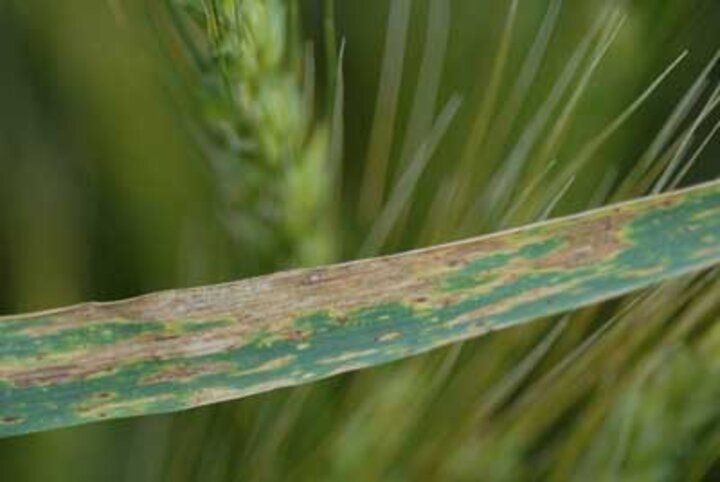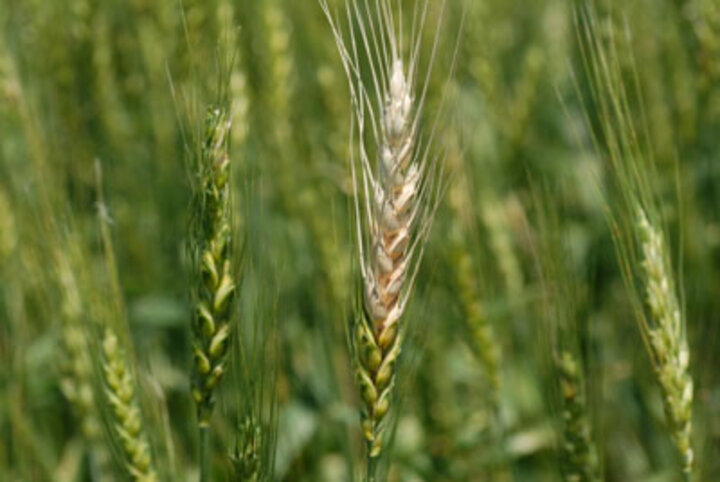July 2, 2008
Double Check the Restrictions for Your Fungicide

|
| Figure 1. Septoria leaf blotch in wheat. |

|
| Figure 2. Fusarium head blight (scab) in wheat. |
The 2008 growing season has been unusually wet especially in south central, eastern, and even southwestern Nebraska. The wet weather favored many diseases. The major diseases were Fusarium head blight (scab, Figure 1) and Septoria leaf blotch (Figure 2). Foliar and head diseases of wheat caused by fungi can be controlled by applying fungicides. However, proper timing of fungicide application is critical in achieving maximum efficacy and meeting legal requirements. This growing season there have been a few instances where fungicides apparently were applied later than they should have been. This article provides information on rates, application timing, number of sprays per season, and preharvest intervals for the most commonly used wheat fungicides in Nebraska (Table I).
| NDA Reminds Producers About Fungicide Restrictions |
In wheat, fungicide application for optimal control of fungal foliar diseases usually is timed to protect the flag leaf. However, for early season diseases such as powdery mildew and tan spot, if conditions are favorable to disease development early in the season, it may be beneficial to apply a fungicide for early season disease suppression and follow up with a second application at flag leaf emergence. If a decision is made to apply two or more sprays, be careful not to exceed the maximum product rate for a single growing season. Also adhere to restrictions regarding the interval between two sprays and the pre-harvest interval.
Wheat Treated Too Close to Harvest
If wheat was treated with a fungicide which has a preharvest interval extending beyond the expected harvest date, wait as long as practical before harvesting. Postponing harvest allows more time for fungicide residue to degrade, which reduces grain contamination.
If you have questions, contact the Nebraska Department of Agriculture at 1-877-800-4080.
Stephen Wegulo
Extension Plant Pathologist
|
Table 1. Application timing and preharvest intervals for wheat fungicides. |
||||||
|
Product* |
Rate/Acre |
Application timing for optimal disease control |
Max. no. |
Max. |
Pre-harvest interval |
Pre-harvest interval |
|
Headline |
6 – 9 fl oz |
Prior to disease development; immediately after flag leaf emergence (Feekes 8) |
2 |
18 fl oz |
Feekes 10.5 |
14 days for hay or feed green-chopped wheat |
|
Quadris |
4 – 12 fl oz; |
Prior to disease development; starting at Feekes 6 (first node of stem visible |
2 |
24 fl oz |
Feekes 10.5 |
14 days for hay; 45 days for grain and straw |
|
Quilt |
7 – 14 fl oz for early season suppression; |
When the flag leaf is 50% fully emerged |
2 |
20.5 fl oz |
Feekes 10.5 |
45 days for grain or straw |
|
Stratego |
10 fl oz |
Preventively when conditions favor disease development |
2 |
20 fl oz |
Feekes 9 (ligule of flag leaf just visible) |
30 days for forage; |
|
Proline |
4.3 – 5.7 fl oz (Fusarium head blight) |
Feekes 10.51 (15% flower) |
2 |
9.37 fl oz |
Feekes 10.52 (50% flower) |
30 days for grain |
|
Folicur |
4 fl oz |
Rusts: at first sign of disease |
1 |
4 fl oz |
Feekes 10.51 (beginning of flowering) |
6 days for forage; 30 days for grain and straw |
|
Caramba |
Diseases other than scab: 10 – 14 fl oz; |
Diseases other than scab: Prior to disease development; immediately after flag leaf emergence (Feekes 8) |
2 |
34 fl oz |
— |
30 days for grain; no livestock feeding restrictions |
|
Tilt |
2 – 4 fl oz for early season suppression; 4 fl oz for control of foliar diseases |
At first appearance of disease; at Feekes 8 (flag leaf emergence) |
2 |
4 fl oz |
�Feekes 10.5 |
30 days for forage; |
|
PropiMax EC |
4 fl oz |
At first appearance of disease; at Feekes 8 |
1 |
4 fl oz |
Feekes 10.5 (heading) |
40 days for grain and straw |
|
Dithane DF |
2.1 lb |
At first appearance of disease in the tillering to jointing stage |
3 |
6.3 lb |
Feekes 10.5 |
26 days for grain and straw |
|
Manzate 75 DF |
2.1 lb |
At first appearance of disease in the tillering to jointing stage |
3 |
6 lb |
Feekes 10.5 |
26 days for grain and straw |
|
*No endorsement is intended for products listed nor is criticism meant for products not listed. |
||||||
